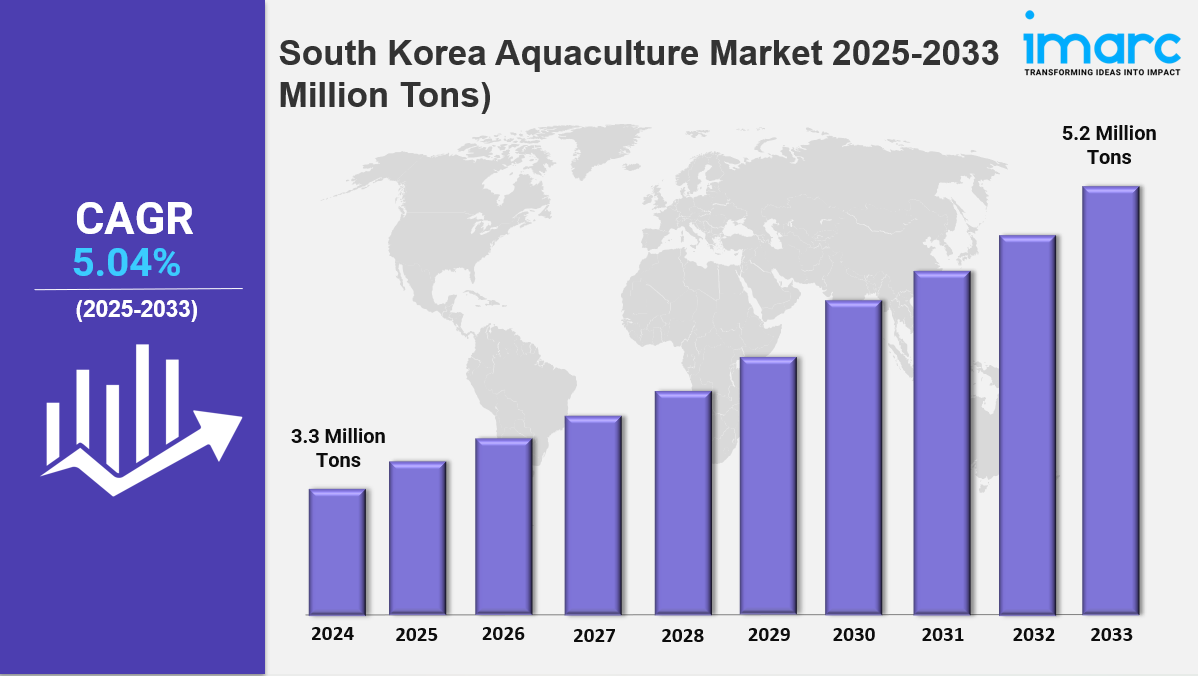Market Overview 2025-2033
The South Korea aquaculture market size reached 3.3 Million Tons in 2024. Looking forward, IMARC Group expects the market to reach 5.2 Million Tons by 2033, exhibiting a growth rate (CAGR) of 5.04% during 2025-2033. The market is expanding due to rising seafood demand, advanced farming technologies, and strong government support. Sustainable practices, innovation in feed and breeding, and increasing exports are driving growth. The industry is evolving rapidly, making it dynamic, efficient, and highly competitive in both domestic and global markets.
Key Market Highlights:
✔️ Strong market growth driven by increasing demand for seafood and protein-rich diets
✔️ Rising adoption of sustainable and technology-driven aquaculture practices
✔️ Expanding government support for marine farming innovations and export-oriented production
Request for a sample copy of the report: https://www.imarcgroup.com/south-korea-aquaculture-market/requestsample
South Korea Aquaculture Market Trends and Drivers:
The South Korea aquaculture market is witnessing steady expansion, fueled by strong government backing and growing consumer demand for premium seafood. Key production hubs such as Jeju and South Gyeongsang are scaling up their operations to serve both domestic needs and increasing international demand, particularly from neighboring countries like Japan and China. With a heightened focus on food security and sustainable sourcing, South Korea is investing in innovative aquaculture techniques that improve yield while minimizing environmental impact. Species like abalone, flounder, and olive flounder are among the primary contributors to the country’s rising aquaculture output.
Sustainability has become a central factor influencing the South Korea aquaculture market size. New regulatory measures from the Ministry of Oceans and Fisheries are encouraging farms to adopt environmentally friendly practices, including closed-containment and recirculating aquaculture systems. These methods aim to reduce pollution, maintain marine biodiversity, and meet growing consumer expectations for safe, traceable seafood. In urban centers like Seoul and Busan, there is increasing demand for responsibly farmed products, further reinforcing the market’s shift toward eco-conscious operations.
Beyond traditional seafood, South Korea is diversifying its aquaculture offerings with value-added products such as seaweed snacks, fermented seafood, and health-oriented goods made from sea cucumbers and omega-3-rich crab. These products are gaining popularity not only in local markets but also internationally, particularly in Southeast Asia and the Middle East. National branding campaigns are helping position Korean aquaculture as a symbol of quality and innovation on the global stage.
A notable development in the sector is the emergence of offshore and hybrid aquaculture projects that integrate renewable energy platforms. These multi-functional installations enhance production efficiency and support the country’s broader goals around climate resilience and energy transition. Government initiatives like the Blue Ocean 2030 fund are accelerating this shift, particularly by supporting offshore ventures in seaweed and finfish farming.
Despite facing competition from regional producers such as Vietnam and navigating complex international trade regulations, South Korea’s seafood exports continue to perform strongly. High-demand products like abalone and kelp are seeing consistent growth in markets like the United States. This robust export performance, combined with increasing domestic interest, is contributing to a rise in South Korea aquaculture market share.
Looking ahead, research and innovation will be critical to sustaining growth amid evolving consumer expectations and environmental challenges. Advances in sustainable feed, low-emission practices, and efficient farming systems are expected to define the next phase of development. With its emphasis on quality, responsibility, and innovation, the South Korea aquaculture market is positioning itself as a leader in the regional seafood industry.
South Korea Aquaculture Market Segmentation:
The report segments the market based on product type, distribution channel, and region:
Study Period:
Base Year: 2024
Historical Year: 2019-2024
Forecast Year: 2025-2033
Breakup by Fish Type:
- Freshwater Fish
- Mollusks
- Crustaceans
- Others
Breakup by Environment:
- Fresh Water
- Marine Water
- Brackish Water
Breakup by Distribution Channel:
- Traditional Retail
- Supermarkets and Hypermarkets
- Specialized Retailers
- Online Stores
- Others
Breakup by Region:
- East
- West
- Southwest
- Southeast
Competitive Landscape:
The market research report offers an in-depth analysis of the competitive landscape, covering market structure, key player positioning, top winning strategies, a competitive dashboard, and a company evaluation quadrant. Additionally, detailed profiles of all major companies are included.
Contact Us:
IMARC Group
134 N 4th St. Brooklyn, NY 11249, USA
Email: sales@imarcgroup.com
Tel No:(D) +91 120 433 0800
United States: +1-631-791-1145
